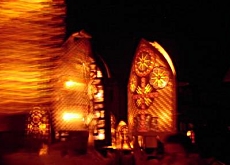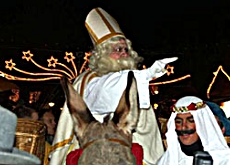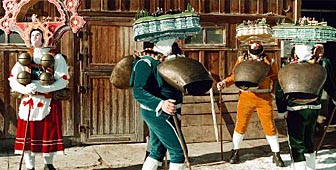The Christmas chase begins…

Christmas shopping is a rite at this time of year, but an ancient Swiss custom – the St Nicholas Chase - keeps commercialism in check.
On the night before St Nicholas or Samichlaus Day, December 6, the central town of Küssnacht upholds an unusual tradition that is as beautiful as it is frightening.
There is an explosion and the town’s lights go out. The loud bang and sudden darkness silence the thousands of spectators lining the streets and alleys.
It is not long before the quiet is broken by the cracking of whips – a noise that penetrates the night like gunshot.
People in the crowd squeeze tightly together, recoiling to avoid being struck by long lengths of ropes no one can see.
The whip crackers move on, illuminated by the occasional camera flash, and the crowd relaxes. There is a sense of relief and joy as the many spectators welcome the approach of a procession of men carrying large candle-lit lanterns on their heads.
There are well over 100 of the cardboard ornaments. Cut out like stain glass windows the “Infuln” resemble oversized bishops’ mitres, bobbing and twisting elegantly atop the figures that perform a slow dance through the streets.
Torchbearers and cowbells
Next comes St Nicholas, accompanied by young torchbearers, and a brass band playing a triad. But the latter’s sombre notes are soon drowned out by the furious ringing of cowbells.
The “Trichler” (bell ringers) come in unending waves. About 1,000 men take part in this deafening march, with a smaller group at the rear blowing cow horns.
“It’s a cross between a Christian celebration and a pagan rite,” explains Tony Gössi, who has participated each year for most of his 67 years and served as the president of the “Klausjagen” (St Nicholas Chase) association for the past 23.
“It has a peaceful quality, which is the Christian aspect, while the noisy part is a reminder of the festival’s pagan roots,” he explains.
There are countless traditions across the Swiss Alps with pre-Christian origins. Many, like Klausjagen, incorporate cowbell ringing as an essential feature. Noise was intended to chase away evil winter spirits.
When Christianity took hold, some of the customs were adapted, and in Küssnacht’s case, St Nicholas and the Ifuln were introduced.
Surviving tradition
The tradition was formalised in 1928 when participants formed the St Nicholas association to guarantee its survival.
Its popularity has not waned. Around 1,400 actively participated in this year’s event in a community with a total population of only 8,500. Even more impressive when considering that it is a men only tradition.
It also attracts thousands of visitors each year who fill up the local hotels. Yet little is done to promote Klausjagen and there are no crass travel agents trying to capitalise on the event by offering hotel packages combining Klausjagen tours and Christmas shopping in nearby Lucerne.
Not commercial
The association has also successfully resisted most attempts to commercialise it. The only notable concession this year was the presence during the day of Coca Cola’s Christmas truck bearing the image of the American Santa Claus.
It made a quiet exit long before the main parade got underway.
“It’s hard to explain the appeal,” says 75-year-old Emil Hurschler, a Klausjagen veteran of 65 years and Infuln maker. He says he spent 500 hours drawing, cutting and punching out the elaborate pattern on his most recent creation.
It is over two metres high, and is too big for Hurschler, only 1.66m tall himself, to carry.
It and his two other large Ifuln are borne by friends and relatives, while he has reserved a smaller one.
“If you are initiated into the Klausjagen rite as a young boy, then you can’t stop,” says Gössi. “You keep going into your old age and only quit when you can no longer walk.”
In keeping with the Christmas spirit, much of the money paid by the association members in fees is put back into the community.
“We support local kindergartens, and pay for the gifts that St Nicholas gives to the children of Küssnacht,” Gössi says.
“We also bring gifts to those in hospital and the residents of our old peoples’ homes, and send packages to local men doing military service.”
swissinfo, Dale Bechtel in Küssnacht
The Klausjagen (St Nicholas Chase) festival takes place every year on December 5, on the eve of St Nicholas’s feast day.
St Nicholas, or Samichlaus in the German-speaking part of Switzerland, traditionally makes his appearance on December 6.
Klausjagen is a blend of both pagan and Christian elements.
The candle-lit Ifuln, or tall ornamental headdresses, are believed to have been introduced in the 19th century or even as late as the beginning of the 20th century.
An association was founded in 1928 to preserve the tradition.

In compliance with the JTI standards
More: SWI swissinfo.ch certified by the Journalism Trust Initiative



You can find an overview of ongoing debates with our journalists here. Please join us!
If you want to start a conversation about a topic raised in this article or want to report factual errors, email us at english@swissinfo.ch.